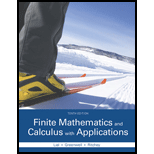
Finite Mathematics and Calculus with Applications (10th Edition)
10th Edition
ISBN: 9780321979407
Author: Margaret L. Lial, Raymond N. Greenwell, Nathan P. Ritchey
Publisher: PEARSON
expand_more
expand_more
format_list_bulleted
Concept explainers
Textbook Question
Chapter 17.1, Problem 26E
Match each equation in Exercises 23–28 with its graph in (a)–(f) below and on the next page.
26.
(a)

(b)
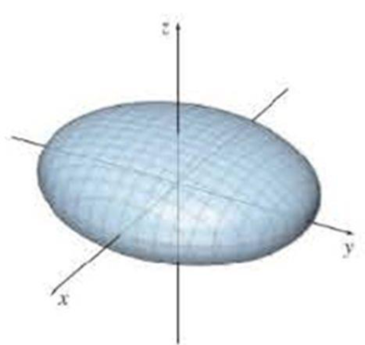
(c)
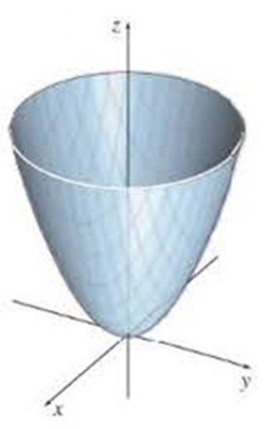
(d)
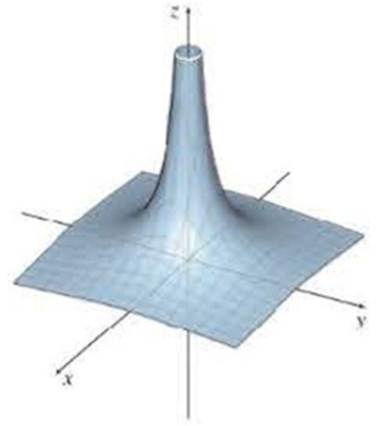
(e)

(f)
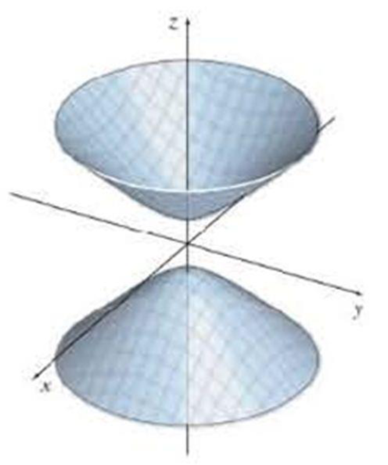
Expert Solution & Answer
Want to see the full answer?
Check out a sample textbook solution
Students have asked these similar questions
The figure shows the graphs of the cost and revenue functions
for a company that manufactures and sells small radios. Use the
information in the figure to solve Exercises 67–72.
35,000
30,000
C(x) = 10,000 + 30x
25,000
20,000
15,000
R(x) = 50x
10,000
5000
100 200 300 400
500 600 700
Radios Produced and Sold
67. How many radios must be produced and sold for the company
to break even?
68. More than how many radios must be produced and sold for
the company to have a profit?
69. Use the formulas shown in the voice balloons to find
R(200) – C(200). Describe what this means for the company.
70. Use the formulas shown in the voice balloons to find
R(300) – C(300). Describe what this means for the company.
71. a. Use the formulas shown in the voice balloons to write the
company's profit function, P, from producing and selling
x radios.
b. Find the company's profit if 10,000 radios are produced
and sold.
72. a. Use the formulas shown in the voice balloons to write the
company's profit function,…
In Exercises 61–64, find an equation for the level surface of the function through the given point.
In Exercises 7–12, describe the relationship between the two quantities.
Chapter 17 Solutions
Finite Mathematics and Calculus with Applications (10th Edition)
Ch. 17.1 - For the function in Example 1, find f(2, 3)....Ch. 17.1 - Prob. 2YTCh. 17.1 - Prob. 3YTCh. 17.1 - Prob. 4YTCh. 17.1 - Prob. 1WECh. 17.1 - Prob. 2WECh. 17.1 - Prob. 3WECh. 17.1 - Prob. 4WECh. 17.1 - Prob. 5WECh. 17.1 - Prob. 6WE
Ch. 17.1 - Let f(x, y) = 2x 3y + 5. Find the following....Ch. 17.1 - Prob. 2ECh. 17.1 - Prob. 3ECh. 17.1 - Prob. 4ECh. 17.1 - Prob. 5ECh. 17.1 - Prob. 6ECh. 17.1 - Prob. 7ECh. 17.1 - Prob. 8ECh. 17.1 - Graph the first-octant portion of each plane. 9.2x...Ch. 17.1 - Prob. 10ECh. 17.1 - Prob. 11ECh. 17.1 - Prob. 12ECh. 17.1 - Prob. 13ECh. 17.1 - Prob. 14ECh. 17.1 - Prob. 15ECh. 17.1 - Prob. 16ECh. 17.1 - Prob. 17ECh. 17.1 - Prob. 18ECh. 17.1 - Prob. 19ECh. 17.1 - Prob. 20ECh. 17.1 - Prob. 21ECh. 17.1 - Prob. 22ECh. 17.1 - Match each equation in Exercises 2328 with its...Ch. 17.1 - Prob. 24ECh. 17.1 - Prob. 25ECh. 17.1 - Match each equation in Exercises 2328 with its...Ch. 17.1 - Prob. 27ECh. 17.1 - Prob. 28ECh. 17.1 - Prob. 29ECh. 17.1 - Prob. 30ECh. 17.1 - Prob. 31ECh. 17.1 - Prob. 32ECh. 17.1 - Prob. 33ECh. 17.1 - Prob. 34ECh. 17.1 - Production Find the level curve at a production of...Ch. 17.1 - Prob. 36ECh. 17.1 - Prob. 37ECh. 17.1 - Individual Retirement Accounts The multiplier...Ch. 17.1 - Individual Retirement Accounts The multiplier...Ch. 17.1 - Heat Loss The rate of heal loss (in watts) in...Ch. 17.1 - Prob. 41ECh. 17.1 - Prob. 42ECh. 17.1 - Pollution Intolerance According to research at the...Ch. 17.1 - Dengue Fever In tropical regions, dengue fever is...Ch. 17.1 - Prob. 45ECh. 17.1 - Prob. 46ECh. 17.1 - Prob. 47ECh. 17.1 - Prob. 48ECh. 17.1 - Prob. 49ECh. 17.1 - Prob. 50ECh. 17.1 - Prob. 51ECh. 17.2 - Prob. 1YTCh. 17.2 - Prob. 2YTCh. 17.2 - Prob. 3YTCh. 17.2 - Prob. 4YTCh. 17.2 - Prob. 1WECh. 17.2 - Prob. 2WECh. 17.2 - Prob. 3WECh. 17.2 - Prob. 4WECh. 17.2 - Prob. 5WECh. 17.2 - Prob. 6WECh. 17.2 - Prob. 7WECh. 17.2 - Prob. 8WECh. 17.2 - Prob. 1ECh. 17.2 - Prob. 2ECh. 17.2 - Prob. 3ECh. 17.2 - Prob. 4ECh. 17.2 - Prob. 5ECh. 17.2 - Prob. 6ECh. 17.2 - Prob. 7ECh. 17.2 - Prob. 8ECh. 17.2 - Prob. 9ECh. 17.2 - Prob. 10ECh. 17.2 - Prob. 11ECh. 17.2 - Prob. 12ECh. 17.2 - Prob. 13ECh. 17.2 - Prob. 14ECh. 17.2 - Prob. 15ECh. 17.2 - Prob. 16ECh. 17.2 - Prob. 17ECh. 17.2 - Prob. 18ECh. 17.2 - Prob. 19ECh. 17.2 - Prob. 20ECh. 17.2 - Prob. 21ECh. 17.2 - Prob. 22ECh. 17.2 - Prob. 23ECh. 17.2 - Prob. 24ECh. 17.2 - Prob. 25ECh. 17.2 - Prob. 26ECh. 17.2 - Prob. 27ECh. 17.2 - Prob. 28ECh. 17.2 - Prob. 29ECh. 17.2 - Prob. 30ECh. 17.2 - Prob. 31ECh. 17.2 - Prob. 32ECh. 17.2 - Prob. 33ECh. 17.2 - Prob. 34ECh. 17.2 - Prob. 35ECh. 17.2 - Prob. 36ECh. 17.2 - Prob. 37ECh. 17.2 - Prob. 38ECh. 17.2 - Prob. 39ECh. 17.2 - Prob. 40ECh. 17.2 - Find fx(x,y,z),fy(x,y,z),fz(x,y,z), and fyz(x,y,z)...Ch. 17.2 - Prob. 42ECh. 17.2 - Prob. 43ECh. 17.2 - Prob. 44ECh. 17.2 - Business and Economics 45.Manufacturing Cost...Ch. 17.2 - Prob. 46ECh. 17.2 - Prob. 47ECh. 17.2 - Prob. 48ECh. 17.2 - Prob. 49ECh. 17.2 - Prob. 50ECh. 17.2 - Prob. 51ECh. 17.2 - Prob. 52ECh. 17.2 - Prob. 53ECh. 17.2 - Prob. 54ECh. 17.2 - Prob. 55ECh. 17.2 - Prob. 56ECh. 17.2 - Prob. 57ECh. 17.2 - Prob. 58ECh. 17.2 - Prob. 59ECh. 17.2 - Prob. 60ECh. 17.2 - Prob. 61ECh. 17.2 - Prob. 62ECh. 17.2 - Drug Reaction The reaction to x units of a drug t...Ch. 17.2 - Prob. 64ECh. 17.2 - Prob. 66ECh. 17.2 - Prob. 67ECh. 17.2 - Prob. 68ECh. 17.2 - Gravitational Attraction The gravitational...Ch. 17.2 - Velocity In 1931, Albert Einstein developed the...Ch. 17.2 - Prob. 71ECh. 17.3 - Prob. 1YTCh. 17.3 - Prob. 2YTCh. 17.3 - Prob. 1WECh. 17.3 - Prob. 2WECh. 17.3 - Prob. 1ECh. 17.3 - Prob. 2ECh. 17.3 - Prob. 3ECh. 17.3 - Prob. 4ECh. 17.3 - Prob. 5ECh. 17.3 - Prob. 6ECh. 17.3 - Prob. 7ECh. 17.3 - Prob. 8ECh. 17.3 - Prob. 9ECh. 17.3 - Prob. 10ECh. 17.3 - Prob. 11ECh. 17.3 - Prob. 12ECh. 17.3 - Prob. 13ECh. 17.3 - Prob. 14ECh. 17.3 - Prob. 15ECh. 17.3 - Prob. 16ECh. 17.3 - Prob. 17ECh. 17.3 - Prob. 18ECh. 17.3 - Prob. 19ECh. 17.3 - Prob. 20ECh. 17.3 - Prob. 21ECh. 17.3 - Prob. 22ECh. 17.3 - Prob. 23ECh. 17.3 - Figures (a)(f) show the graphs of the functions...Ch. 17.3 - Prob. 25ECh. 17.3 - Prob. 26ECh. 17.3 - Prob. 27ECh. 17.3 - Prob. 28ECh. 17.3 - Prob. 29ECh. 17.3 - Prob. 30ECh. 17.3 - Prob. 31ECh. 17.3 - Prob. 32ECh. 17.3 - Prob. 33ECh. 17.3 - Prob. 34ECh. 17.3 - Prob. 35ECh. 17.3 - Prob. 36ECh. 17.3 - Prob. 37ECh. 17.3 - Prob. 38ECh. 17.3 - Prob. 39ECh. 17.3 - Prob. 40ECh. 17.3 - Prob. 42ECh. 17.4 - Prob. 1YTCh. 17.4 - Prob. 1WECh. 17.4 - Prob. 2WECh. 17.4 - Find the relative maxima or minima in Exercises...Ch. 17.4 - Find the relative maxima or minima in Exercises...Ch. 17.4 - Find the relative maxima or minima in Exercises...Ch. 17.4 - Find the relative maxima or minima in Exercises...Ch. 17.4 - Find the relative maxima or minima in Exercises...Ch. 17.4 - Find the relative maxima or minima in Exercises...Ch. 17.4 - Find the relative maxima or minima in Exercises...Ch. 17.4 - Find the relative maxima or minima in Exercises...Ch. 17.4 - Find the relative maxima or minima in Exercises...Ch. 17.4 - Find the relative maxima or minima in Exercises...Ch. 17.4 - Prob. 11ECh. 17.4 - Find positive numbers x and y such that x + y = 48...Ch. 17.4 - Prob. 13ECh. 17.4 - Prob. 14ECh. 17.4 - Find the maximum and minimum values of f(x, y) =x3...Ch. 17.4 - Prob. 16ECh. 17.4 - Prob. 17ECh. 17.4 - Prob. 18ECh. 17.4 - Prob. 19ECh. 17.4 - Prob. 20ECh. 17.4 - Prob. 21ECh. 17.4 - Discuss the advantages and disadvantages of the...Ch. 17.4 - Prob. 23ECh. 17.4 - Prob. 24ECh. 17.4 - Prob. 25ECh. 17.4 - Prob. 26ECh. 17.4 - Prob. 27ECh. 17.4 - Prob. 28ECh. 17.4 - Prob. 29ECh. 17.4 - Prob. 30ECh. 17.4 - Prob. 31ECh. 17.4 - Prob. 32ECh. 17.4 - Prob. 33ECh. 17.4 - Prob. 34ECh. 17.4 - Prob. 35ECh. 17.4 - Prob. 36ECh. 17.4 - Prob. 37ECh. 17.4 - Prob. 38ECh. 17.4 - Prob. 39ECh. 17.4 - Prob. 40ECh. 17.4 - Prob. 41ECh. 17.4 - Prob. 42ECh. 17.5 - Prob. 1YTCh. 17.5 - Prob. 2YTCh. 17.5 - Prob. 3YTCh. 17.5 - Prob. 1WECh. 17.5 - Prob. 2WECh. 17.5 - Prob. 3WECh. 17.5 - Prob. 4WECh. 17.5 - Prob. 1ECh. 17.5 - Prob. 2ECh. 17.5 - Prob. 3ECh. 17.5 - Prob. 4ECh. 17.5 - Prob. 5ECh. 17.5 - Prob. 6ECh. 17.5 - Prob. 7ECh. 17.5 - Prob. 8ECh. 17.5 - Prob. 9ECh. 17.5 - Prob. 10ECh. 17.5 - Prob. 11ECh. 17.5 - Prob. 12ECh. 17.5 - Prob. 13ECh. 17.5 - Prob. 14ECh. 17.5 - Prob. 15ECh. 17.5 - Prob. 16ECh. 17.5 - Volume of a Coating An industrial coaling 0.1 in....Ch. 17.5 - Prob. 18ECh. 17.5 - Prob. 19ECh. 17.5 - Prob. 20ECh. 17.5 - Prob. 21ECh. 17.5 - Prob. 22ECh. 17.5 - Prob. 23ECh. 17.5 - Prob. 24ECh. 17.5 - Life Span As we saw in Exercise 62 of Section...Ch. 17.5 - Prob. 26ECh. 17.5 - Prob. 27ECh. 17.5 - Prob. 28ECh. 17.5 - Prob. 29ECh. 17.5 - Prob. 30ECh. 17.5 - Prob. 31ECh. 17.5 - Prob. 32ECh. 17.5 - Prob. 33ECh. 17.5 - Prob. 34ECh. 17.5 - Prob. 35ECh. 17.6 - Prob. 1YTCh. 17.6 - Evaluate 02[13(6x2y2+4xy+8x3+10y4+3)dy]dx and then...Ch. 17.6 - Prob. 3YTCh. 17.6 - Prob. 4YTCh. 17.6 - Prob. 5YTCh. 17.6 - Prob. 1WECh. 17.6 - Evaluate each definite integral. W2.23x+6dxCh. 17.6 - Prob. 3WECh. 17.6 - Prob. 4WECh. 17.6 - Prob. 5WECh. 17.6 - Prob. 6WECh. 17.6 - Prob. 1ECh. 17.6 - Prob. 2ECh. 17.6 - Prob. 3ECh. 17.6 - Prob. 4ECh. 17.6 - Prob. 5ECh. 17.6 - Prob. 6ECh. 17.6 - Prob. 7ECh. 17.6 - Prob. 8ECh. 17.6 - Prob. 9ECh. 17.6 - Prob. 10ECh. 17.6 - Prob. 11ECh. 17.6 - Prob. 12ECh. 17.6 - Prob. 13ECh. 17.6 - Prob. 14ECh. 17.6 - Prob. 15ECh. 17.6 - Prob. 16ECh. 17.6 - Prob. 17ECh. 17.6 - Prob. 18ECh. 17.6 - Prob. 19ECh. 17.6 - Prob. 20ECh. 17.6 - Prob. 21ECh. 17.6 - Prob. 22ECh. 17.6 - Prob. 23ECh. 17.6 - Prob. 24ECh. 17.6 - Prob. 25ECh. 17.6 - Prob. 26ECh. 17.6 - Prob. 27ECh. 17.6 - Prob. 28ECh. 17.6 - Prob. 29ECh. 17.6 - Prob. 30ECh. 17.6 - Prob. 31ECh. 17.6 - Prob. 32ECh. 17.6 - Prob. 33ECh. 17.6 - Prob. 34ECh. 17.6 - Prob. 35ECh. 17.6 - Prob. 36ECh. 17.6 - Prob. 37ECh. 17.6 - Prob. 38ECh. 17.6 - Prob. 39ECh. 17.6 - Prob. 40ECh. 17.6 - Prob. 41ECh. 17.6 - Prob. 42ECh. 17.6 - Prob. 43ECh. 17.6 - Use the region R with the indicated boundaries to...Ch. 17.6 - Prob. 45ECh. 17.6 - Prob. 46ECh. 17.6 - Prob. 47ECh. 17.6 - Prob. 48ECh. 17.6 - Prob. 49ECh. 17.6 - Prob. 50ECh. 17.6 - Prob. 51ECh. 17.6 - Prob. 52ECh. 17.6 - Prob. 53ECh. 17.6 - Prob. 54ECh. 17.6 - Prob. 55ECh. 17.6 - Prob. 56ECh. 17.6 - Prob. 57ECh. 17.6 - Prob. 58ECh. 17.6 - Prob. 59ECh. 17.6 - Prob. 60ECh. 17.6 - Prob. 61ECh. 17.6 - Prob. 62ECh. 17.6 - Prob. 63ECh. 17.6 - Prob. 64ECh. 17.6 - Prob. 65ECh. 17.6 - Prob. 66ECh. 17.6 - Prob. 67ECh. 17.6 - Prob. 68ECh. 17.6 - Prob. 69ECh. 17.6 - Time In Exercise 39 of Section 17.3, we saw that...Ch. 17.6 - Profit In Exercise 38 of Section 17.3, we saw that...Ch. 17 - Determine whether each of the following statements...Ch. 17 - Prob. 2RECh. 17 - Prob. 3RECh. 17 - Prob. 4RECh. 17 - Prob. 5RECh. 17 - Prob. 6RECh. 17 - Prob. 7RECh. 17 - Prob. 8RECh. 17 - Prob. 9RECh. 17 - Prob. 10RECh. 17 - Prob. 11RECh. 17 - Prob. 12RECh. 17 - Prob. 13RECh. 17 - Prob. 14RECh. 17 - Prob. 15RECh. 17 - Prob. 16RECh. 17 - Prob. 17RECh. 17 - Prob. 18RECh. 17 - Prob. 19RECh. 17 - Prob. 20RECh. 17 - Prob. 21RECh. 17 - Prob. 22RECh. 17 - Prob. 23RECh. 17 - Prob. 24RECh. 17 - Prob. 25RECh. 17 - Prob. 26RECh. 17 - Prob. 27RECh. 17 - Prob. 28RECh. 17 - Prob. 29RECh. 17 - Prob. 30RECh. 17 - Prob. 31RECh. 17 - Prob. 32RECh. 17 - Prob. 33RECh. 17 - Prob. 34RECh. 17 - Prob. 35RECh. 17 - Prob. 36RECh. 17 - Prob. 37RECh. 17 - Prob. 38RECh. 17 - Prob. 39RECh. 17 - Prob. 40RECh. 17 - Prob. 41RECh. 17 - Prob. 42RECh. 17 - Prob. 43RECh. 17 - Prob. 44RECh. 17 - Prob. 45RECh. 17 - Prob. 46RECh. 17 - Prob. 47RECh. 17 - Prob. 48RECh. 17 - Prob. 49RECh. 17 - Prob. 50RECh. 17 - Prob. 51RECh. 17 - Prob. 52RECh. 17 - Prob. 53RECh. 17 - Prob. 54RECh. 17 - Prob. 55RECh. 17 - Prob. 56RECh. 17 - Prob. 57RECh. 17 - Prob. 58RECh. 17 - Evaluate dz using the given information. 59.z =...Ch. 17 - Prob. 60RECh. 17 - Prob. 61RECh. 17 - Prob. 62RECh. 17 - Prob. 63RECh. 17 - Prob. 64RECh. 17 - Prob. 65RECh. 17 - Prob. 66RECh. 17 - Prob. 67RECh. 17 - Prob. 68RECh. 17 - Prob. 69RECh. 17 - Prob. 70RECh. 17 - Prob. 71RECh. 17 - Prob. 72RECh. 17 - Prob. 73RECh. 17 - Prob. 74RECh. 17 - Prob. 75RECh. 17 - Prob. 76RECh. 17 - Prob. 77RECh. 17 - Prob. 78RECh. 17 - Prob. 79RECh. 17 - Prob. 80RECh. 17 - Prob. 81RECh. 17 - Prob. 82RECh. 17 - Prob. 83RECh. 17 - Evaluate each double integral. If the function...Ch. 17 - Prob. 85RECh. 17 - Prob. 86RECh. 17 - Prob. 87RECh. 17 - Prob. 88RECh. 17 - Prob. 89RECh. 17 - Prob. 90RECh. 17 - Prob. 91RECh. 17 - Prob. 92RECh. 17 - Prob. 93RECh. 17 - Prob. 94RECh. 17 - Prob. 95RECh. 17 - Prob. 96RECh. 17 - Profit The total profit from 1 acre of a certain...Ch. 17 - Prob. 98RECh. 17 - Prob. 99RECh. 17 - Prob. 100RECh. 17 - Prob. 101RECh. 17 - Prob. 102RECh. 17 - Prob. 103RECh. 17 - Prob. 104RECh. 17 - Prob. 105RECh. 17 - Prob. 106RE
Knowledge Booster
Learn more about
Need a deep-dive on the concept behind this application? Look no further. Learn more about this topic, calculus and related others by exploring similar questions and additional content below.Similar questions
- In Exercises 17–19, graph each equation in a rectangular coordinate system. 17. y = 2x – 1 18. y = 1 - |x| 19. y = x + 2 %3Darrow_forwardGraph the functions in Exercises 35. y = Vx + 4arrow_forwardThe average amount A (in pounds per person) of fish and shellfish consumed in the UnitedStates during the period 1992–2001 can be modeled by A = (3.2x + 260)/(52x + 3800) where x is the number of years since 1992.Rewrite the model so that it has only whole number coefficients. Then simplify the model.arrow_forward
- Use this information to solve Exercises 9–11:A company is planning to produce and sell a new line of computers. The fixed cost will be $360,000 and it will cost $850 to produce each computer. Each computer will be sold for $1150. 9. Write the cost function, C, of producing x computers. 10. Write the revenue function, R, from the sale of x computers. 11. Determine the break-even point. Describe what this means.arrow_forwardSec3.3#7.arrow_forwardIn Exercises 65–68, find and sketch the domain of ƒ. Then find an equation for the level curve or surface of the function passing through the given point.arrow_forward
- Your cardiac index is your heart's output, in liters of blood per minute, divided by your body's surface area, in square meters. The cardiac index, C(x), can be modeled by 7.644 C(x) = 10 s xs 80, where x is an individual's age, in years. The graph of the function is shown. Use the function to solve Exercises 95–96. 7.644 C(x) = %3D 10 20 30 40 50 60 70 80 90 Age 95. a. Find the cardiac index of a 32-year-old. Express the denominator in simplified radical form and reduce the fraction. b. Use the form of the answer in part (a) and a calculator to express the cardiac index to the nearest hundredth. Identify your solution as a point on the graph. 96. a. Find the cardiac index of an 80-year-old. Express the denominator in simplified radical form and reduce the fraction. Cardiac Index liters per minute squar e met ers 654 32arrow_forwardIn Exercises 37–38, graph the two equations and find the points at which the graphs intersect. 37. y = -x2, y = 2x2 - 1 38. x2 + y2 = 1, (x - 1)2 + y2 = 1arrow_forwardInsurance Rates The following table gives themonthly insurance rates for a $100,000 life insurancepolicy for smokers 35–50 years of age.a. Create a scatter plot for the data.b. Does it appear that a quadratic function can beused to model the data? If so, find the best-fittingquadratic model.c. Find the power model that is the best fit for the data.d. Compare the two models by graphing each modelon the same axes with the data points. Whichmodel appears to be the better fit?arrow_forward
arrow_back_ios
arrow_forward_ios
Recommended textbooks for you
- Algebra & Trigonometry with Analytic GeometryAlgebraISBN:9781133382119Author:SwokowskiPublisher:Cengage

Algebra & Trigonometry with Analytic Geometry
Algebra
ISBN:9781133382119
Author:Swokowski
Publisher:Cengage
Finding The Focus and Directrix of a Parabola - Conic Sections; Author: The Organic Chemistry Tutor;https://www.youtube.com/watch?v=KYgmOTLbuqE;License: Standard YouTube License, CC-BY